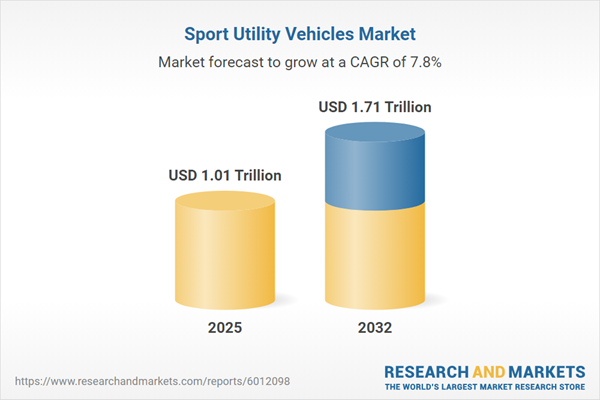Speak directly to the analyst to clarify any post sales queries you may have.
Senior automotive executives require up-to-date, actionable insight to navigate the evolving Sport Utility Vehicles (SUV) market. As this sector rapidly adapts to consumer preference shifts, regulatory changes, and technological innovation, decision-makers need a comprehensive resource offering clarity on growth drivers, risks, and opportunities.
Market Snapshot: Sport Utility Vehicles Market Overview
The Sport Utility Vehicles Market grew from USD 940.36 billion in 2024 to USD 1.01 trillion in 2025. It is expected to continue growing at a CAGR of 7.76%, reaching USD 1.71 trillion by 2032. Growth has been propelled by evolving consumer preferences for performance, versatility, and advanced safety, alongside manufacturers' focus on integrating next-generation technology and compliance with emissions standards. Powertrain diversification, digital engagement, and expanding regional production provide a dynamic backdrop for ongoing market expansion.
Scope & Segmentation: Strategic Coverage Across the Sport Utility Vehicles Market
- Vehicle Class: Compact SUV, Full Size SUV, Luxury SUV, Mid Size SUV
- Fuel Type: Diesel, Gasoline, Battery Electric, Full Hybrid, Mild Hybrid, Plug In Hybrid
- Drivetrain: All Wheel Drive, Four Wheel Drive, Front Wheel Drive, Rear Wheel Drive, Two Wheel Drive
- Engine Capacity: Up To 1.5 L, 1.6 To 2.0 L, 2.1 To 3.0 L, Above 3.0 L
- Customer Type: Fleet, Personal
- Application: Commercial Use, Personal Use
- Sales Channel: Authorized Dealer, Independent Dealer, OEM Direct, Third Party Platform
- Geographic Coverage: Americas (including US, Canada, Mexico, Brazil, Argentina, Chile, Colombia, Peru), Europe, Middle East & Africa (United Kingdom, Germany, France, Russia, Italy, Spain, Netherlands, Sweden, Poland, Switzerland, United Arab Emirates, Saudi Arabia, Qatar, Turkey, Israel, South Africa, Nigeria, Egypt, Kenya), Asia-Pacific (China, India, Japan, Australia, South Korea, Indonesia, Thailand, Malaysia, Singapore, Taiwan)
- Key Companies Profiled: Toyota Motor Corporation, Volkswagen AG, Ford Motor Company, General Motors Company, Stellantis N.V., Hyundai Motor Company, Nissan Motor Co., Ltd., Honda Motor Co., Ltd., Bayerische Motoren Werke Aktiengesellschaft, Mercedes-Benz Group AG
Key Takeaways for Senior Decision-Makers
- Heightened consumer demand is accelerating the integration of advanced driver assistance, connectivity, and electrification across SUV product lines.
- Technological advancements are central to competitive advantage, enabling customizable platforms and streamlined digital retail experiences.
- OEMs are actively reshaping supply chains and production footprints, particularly in response to regional regulatory and tariff developments.
- Sustainability imperatives are compelling automakers to enhance material sourcing, support end-of-life recycling, and develop circular battery programs.
- Distribution models are widening, combining traditional dealer networks with online sales platforms and direct-to-consumer channels to extend reach.
- The segment’s complexity is deepened by multidimensional segmentation, requiring targeted approaches to regional consumer preferences and regulatory compliance.
Tariff Impact on SUV Supply Chains and Profitability
United States tariff measures scheduled for 2025 are prompting manufacturers to review sourcing strategies and localize production, particularly for steel, aluminum, and semiconductor components. These adjustments may influence cost structures, fleet pricing, and supplier relationships, driving margin management through both operational efficiency and targeted product pricing.
Methodology & Data Sources
Insights are derived from primary interviews with automotive executives, suppliers, aftermarket participants, and regulators, combined with secondary research from industry publications and corporate disclosures. Rigorous cross-referencing, peer review, and structured analytical models—such as SWOT, PESTLE, and scenario analysis—support the reliability and depth of these findings.
Why This Report Matters: Supporting Informed Strategic Decisions
- Gain clarity on evolving consumer adoption patterns and technology roadmaps within the sport utility vehicles market.
- Benchmark strategic responses to emerging technology, regulatory pressure, and competitive shifts in major regional markets.
- Identify practical, actionable strategies for supply chain resilience, sustainable growth, and digital transformation.
Conclusion
Fully understanding the interlinked forces shaping the global sport utility vehicles market equips leaders to make decisions that secure long-term value. Drawing on deep analysis of emerging trends, this report supports a resilient and adaptable approach to sector innovation and profitability.
Additional Product Information:
- Purchase of this report includes 1 year online access with quarterly updates.
- This report can be updated on request. Please contact our Customer Experience team using the Ask a Question widget on our website.
Table of Contents
3. Executive Summary
4. Market Overview
7. Cumulative Impact of Artificial Intelligence 2025
Companies Mentioned
The companies profiled in this Sport Utility Vehicles market report include:- Toyota Motor Corporation
- Volkswagen AG
- Ford Motor Company
- General Motors Company
- Stellantis N.V.
- Hyundai Motor Company
- Nissan Motor Co., Ltd.
- Honda Motor Co., Ltd.
- Bayerische Motoren Werke Aktiengesellschaft
- Mercedes-Benz Group AG
Table Information
| Report Attribute | Details |
|---|---|
| No. of Pages | 196 |
| Published | October 2025 |
| Forecast Period | 2025 - 2032 |
| Estimated Market Value ( USD | $ 1.01 Trillion |
| Forecasted Market Value ( USD | $ 1.71 Trillion |
| Compound Annual Growth Rate | 7.7% |
| Regions Covered | Global |
| No. of Companies Mentioned | 11 |









